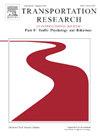Effect of Traffic Sign’s Information Supply Speed on Driver Performance at Tunnel Entrances
IF 3.5
2区 工程技术
Q1 PSYCHOLOGY, APPLIED
Transportation Research Part F-Traffic Psychology and Behaviour
Pub Date : 2025-03-12
DOI:10.1016/j.trf.2025.03.005
引用次数: 0
Abstract
The entrance zones of highway tunnels present a visually complex environment, often requiring multiple traffic signs to ensure driving safety. However, excessive information or improperly positioned traffic signs may cause cognitive overload, hinder their ability to adapt to changing driving conditions and compromise traffic safety. This study aims to assess the effect of traffic signs information supply speed (TSISS), which considers factors such as traffic sign information (TSI), combined installation and spacing of traffic signs, and speed limits on the road, on driving performance and CL. The study collected four types of performance data: eye movement, electroencephalogram (EEG), driving behavior, and subjective cognitive load (SCL). A driving simulator experiment used six TSISSs at the highway tunnel entrance zone: 0.333, 0.400, 0.500, 0.600, 0.667, and 0.833 items/s. An “item” is an independent directive or command of traffic signs. The results showed that as the TSISS increased, pupil area, scan rate, θ wave absolute power, longitudinal acceleration, steering wheel angle, and SCL significantly increased. In contrast, blink frequency, α wave absolute power, and vehicle longitudinal speed decreased. When the TSISS did not exceed 0.600 items/s, the efficiency values calculated by the data envelopment analysis model were high (more than 0.950). However, when the TSISS exceeded 0.600 items/s, the efficiency significantly decreased (below 0.850). Based on these findings, 0.600 items/s is recommended as the optimal threshold for TSISS at highway tunnel entrances. These findings can help evaluate the rationality and effectiveness of traffic sign placement at tunnel entrances, providing essential theoretical bases and practical guidelines for optimizing the overall design of highway traffic signs.
隧道入口交通标志信息供给速度对驾驶员行为的影响
公路隧道入口区域呈现出复杂的视觉环境,往往需要多个交通标志来保证行车安全。然而,过多的信息或位置不正确的交通标志可能会导致认知超载,阻碍他们适应不断变化的驾驶条件和危害交通安全。本研究旨在评估交通标志信息供给速度(TSISS)对驾驶性能和CL的影响,该速度考虑了交通标志信息(TSI)、交通标志组合安装和间距、道路限速等因素。本研究收集了眼球运动、脑电图(EEG)、驾驶行为和主观认知负荷(SCL)四种表现数据。驾驶模拟器实验采用公路隧道入口区6个tisss,分别为0.333、0.400、0.500、0.600、0.667、0.833项/s。“项目”是交通标志的独立指令或命令。结果表明,随着TSISS的增加,瞳孔面积、扫描速率、θ波绝对功率、纵向加速度、方向盘角度和SCL均显著增加。而眨眼频率、α波绝对功率和车速均降低。当tiss不超过0.600项/s时,数据包络分析模型计算的效率值较高(大于0.950)。然而,当tiss超过0.600项/s时,效率显著下降(低于0.850)。基于以上结果,建议将0.600项/秒作为公路隧道入口tiss的最佳阈值。研究结果有助于评价隧道入口交通标志设置的合理性和有效性,为优化公路交通标志的整体设计提供必要的理论依据和实践指导。
本文章由计算机程序翻译,如有差异,请以英文原文为准。
求助全文
约1分钟内获得全文
求助全文
来源期刊
CiteScore
7.60
自引率
14.60%
发文量
239
审稿时长
71 days
期刊介绍:
Transportation Research Part F: Traffic Psychology and Behaviour focuses on the behavioural and psychological aspects of traffic and transport. The aim of the journal is to enhance theory development, improve the quality of empirical studies and to stimulate the application of research findings in practice. TRF provides a focus and a means of communication for the considerable amount of research activities that are now being carried out in this field. The journal provides a forum for transportation researchers, psychologists, ergonomists, engineers and policy-makers with an interest in traffic and transport psychology.

 求助内容:
求助内容: 应助结果提醒方式:
应助结果提醒方式:


